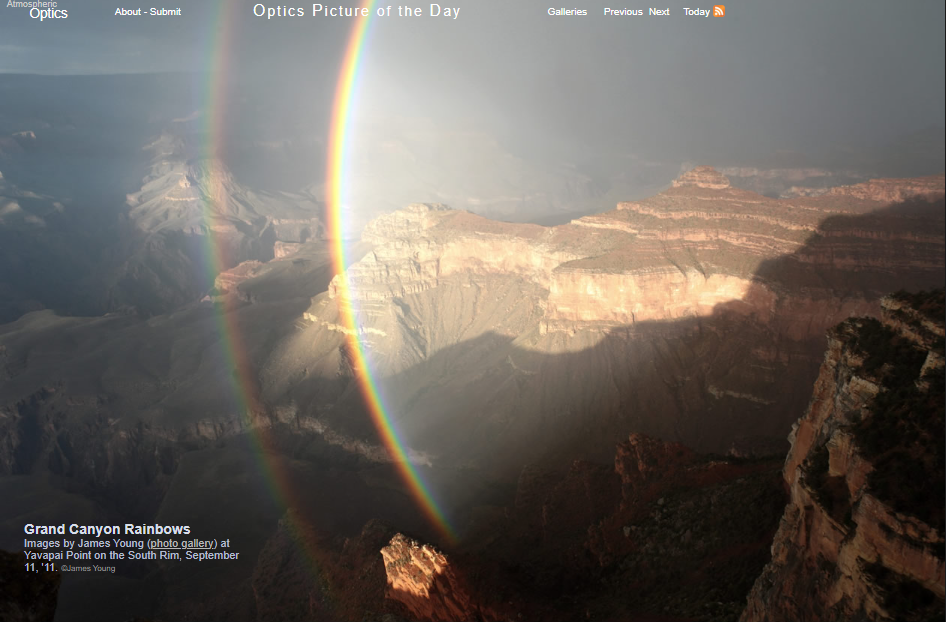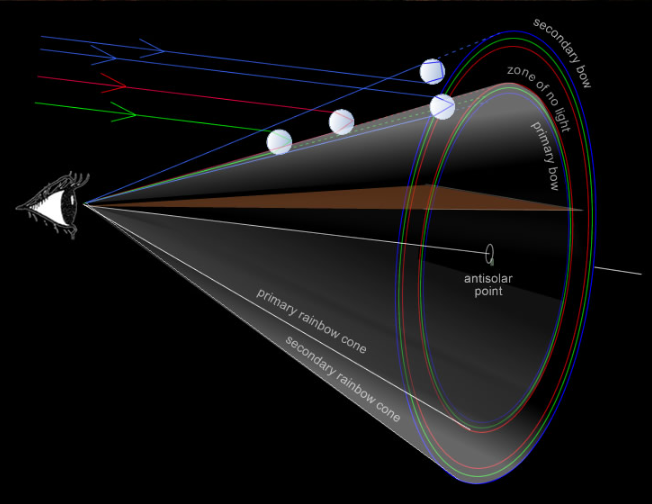OPOD - Grand Canyon Bows
OPOD - Grand Canyon Bows: A Spectacular Display of Atmospheric Optics
When it comes to atmospheric optics, one of the most breathtaking displays is the occurrence of rainbows. And at the Grand Canyon, this natural phenomenon takes on an even more awe-inspiring appearance. In this article, we will delve into the details of the mesmerizing rainbow display captured by James Young at Yavapai Point on the South Rim.
The rainstorm that passed over the canyon on that fateful day created a spectacular and vibrant rainbow. What immediately caught the attention of observers were the vivid primary and secondary bows. The primary bow, formed by a single reflection inside raindrops, exhibited a beautiful array of colors. The secondary bow, resulting from two internal reflections, showcased a stunning reversal of colors. Both bows were concentric and centered on the antisolar point, which added to their captivating appeal.
However, it is worth noting that camera distortions may cause the distance between the bows to appear variable. Despite this, there are other subtle features within the rainbow display that deserve attention. For instance, the sky inside the primary bow appeared brighter, while outside the secondary bow, the sky also exhibited increased brightness. Additionally, between the two bows, there was an area of darkness known as Alexander's Dark Band, named after Alexander of Aphrodisias, who first recorded this phenomenon in 200 AD.
To understand the formation of the colored rims in rainbows, we must consider the glints of light from water drops near the edge of two "rainbow cones." These cones have a common apex at the observer's eye and their axes point towards the antisolar point. The primary bow's inner cone has an apex half angle of 42 degrees.
Within these cones, individual glints of colored light overlap in such a way that we perceive the distinct colors of the rainbow. However, raindrops farther from the cone surfaces also produce glints of colored light, but the overlapping colors result in a white glow instead. This glow is visible inside the primary cone and outside the secondary cone, adding to the ethereal beauty of the rainbow.
Interestingly, raindrops located between the two cones do not contribute to the rainbow seen by the observer. While they do produce glints of colored light, these glints are directed away from the observer and contribute to someone else's rainbow instead. This raises an intriguing question: does a rainbow truly exist if there is no one there to witness it?
The grandeur of the Grand Canyon bows serves as a reminder of the intricate and captivating nature of atmospheric optics. The interplay between light, water droplets, and our perception creates these mesmerizing displays that continue to captivate and inspire us. So, the next time you find yourself at the Grand Canyon after a rainstorm, keep your eyes peeled for the enchanting rainbows that adorn the sky, showcasing the wonders of our natural world.

Grand Canyon Rainbows
Images by James Young (photo gallery) at Yavapai Point on the South Rim, September 11, '11. ©James Young

A rainstorm over the canyon has given an incredibly bright and classical rainbow display. What caught most eyes were the colourful primary (one reflection inside raindrops) and reversed colour secondary (two internal reflections). The bows are concentric and centered on the antisolar point � Camera distortions make the distance between them appear to vary.
More subtle features are the brighter sky inside the primary and outside the secondary. Between the bows there is darkness � Alexanders Dark Band. Not in this case the name of a pop group but after Alexander of Aphrodisias who first recorded it around 200AD.
The coloured rims of rainbows are formed by glints from water drops near the edge of two �rainbow cones� whose common apex is at the eye and whose axes point towards the antisolar point. The inner cone of the primary bow has an apex half angle of 42�.
It is only near the cone surfaces that individual coloured glints overlap sufficiently little that we can see the colours. Raindrops further from the cone surface also glint their coloured light but then there is so much colour overlap that we see instead a white glow. The glow is inside the primary cone and outside the secondary cone.
Raindrops between the two cones cannot glint any light towards the eye. They do glint coloured light but it is directed away to someone else�s rainbow. Does a rainbow exist when no one is there to see it?

Note: this article has been automatically converted from the old site and may not appear as intended. You can find the original article here.
Reference Atmospheric Optics
If you use any of the definitions, information, or data presented on Atmospheric Optics, please copy the link or reference below to properly credit us as the reference source. Thank you!
-
<a href="https://atoptics.co.uk/blog/opod-grand-canyon-bows/">OPOD - Grand Canyon Bows</a>
-
"OPOD - Grand Canyon Bows". Atmospheric Optics. Accessed on November 26, 2024. https://atoptics.co.uk/blog/opod-grand-canyon-bows/.
-
"OPOD - Grand Canyon Bows". Atmospheric Optics, https://atoptics.co.uk/blog/opod-grand-canyon-bows/. Accessed 26 November, 2024
-
OPOD - Grand Canyon Bows. Atmospheric Optics. Retrieved from https://atoptics.co.uk/blog/opod-grand-canyon-bows/.